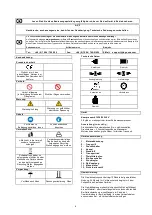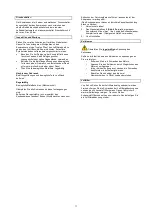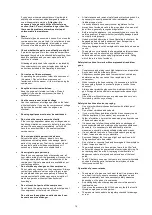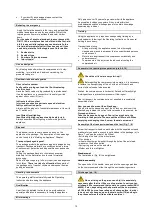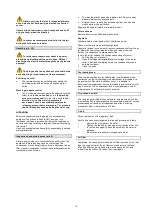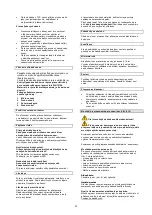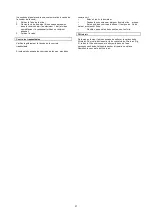
•
If you identify any damage please contact the
customer service w orkshop.
Behaving in em ergency
Apply the first aid adequate to the injury and get qualified
medical assistance as quickly as possible. Protect the
injured person from more accidents and calm him/her
dow n.
For the sake of eventual accident, in accordance w ith
DIN 13164, a w orkplace has to be fitted w ith a first-aid
kit. It is essential to replace any used m aterial in the
first-aid kit im m ediately after it has been used. If you
seek help, state the following pieces of information:
1. Accident site
2. Accident type
3. Num ber of injured persons
4. Injury type(s)
Use as designed
For blow ing and soft w orks w ith compressed air, in clay-
modelling, for w all airbrush, airbrush varnishing, tire
pressure rating, etc.
Residual risks and safeguards
Direct electric contact
Faulty cable or plug can lead to a life-threatening
electric shock.
Have the faulty cable or plug replaced by a professional.
Use the appliance on a connector w ith a safety sw itch
against stray current (FI) only.
Indirect electric contact
Injuries by conductive parts at exposed electric or
faulty construction parts.
Alw ays pull the plug out of socket at maintenance. Use w ith
an FI sw itch only.
Insufficient local lighting
Insufficient lighting represents a high safety risk.
Alw ays ensure sufficient lighting w hen w orking w ith the
appliance.
Disposal
The disposal instructions are based on icons on the
appliance or its package. The description of their meanings
can be found in the “Marking on Appliance“ Chapter.
Transport package disposal
The package protects the appliance against damage during
transport. Package materials are usually selected in terms
of environment protection and disposal manner and can be
recycled.
Putting the package back into circulation saves raw
materials for the material and cuts costs for material
processing.
Parts of the package (e.g. foils, styropor) can be dangerous
for children.
There is a risk of suffocation!
Keep parts of
the package out of reach of children and dispose them as
quickly as possible.
Handling requirements
The operating staff must carefully read the Operating
Instructions before using the appliance.
Qualification
Apart from the detailed instruction by a professional no
special qualification is necessary for using the appliance.
Minim um age
Only persons over 16 years of age can w ork w ith the appliance.
An exception includes youngsters if they w ork w ithin their
professional education w hose purpose is to obtain know ledge
supervised by a trainer.
Training
Using the appliance only requires corresponding training by a
professional or follow ing of the Operating Instructions. No special
training is necessary.
Transport and storing
•
At longer storing, the appliance needs to be thoroughly
cleaned and placed in a manner that no unauthorised persons
could access it.
•
Never store and transport the compressor horizontally and
under pressure!
•
The pressure in the air jet can be reduced at cooling the
compressed air.
Assembly / first putting into operation (pic. 5-8, 10)
Check the oil level at every start-up!!!
Before putting the compressor into operation, it is necessary
to replace the transport peg of the oil w ith an oil fill mouth and
correct oil level needs to be ensured.
Position the compressor on a horizontal, flat and sufficiently high
w orking surface to prevent compressor oil flow ing out.
Due to transport, the compressor is not supplied in a completely
assembled state.
Now you need to m ount the oil tank peg:
You must take the transport peg of the oil tank out and insert the
attached peg instead the correct oil level needs to be ensured, too.
Proceed as follow s:
Take the transport oil peg out. Pour oil as m uch as to the
m arking in the aperture. Then m ount the oil fill m outh. When
em ptying or changing the oil, screw the drain screw out.
Assembly of the transport wheels and the feet (Fig. 7 / 8)
Screw the transport w heels on each side w ith the supplied nuts and
w ashers to (you need a w rench is not included in the package is). In
Figure 7 you see the order of the Wheel:
• bolt through the hole in the w heel press
• Disc enclose
• w heel w ith screw and w asher through the hole of the axle lead.
• w asher on the bolt end slide
• Spring ring screw s on the end slide
• Mother and turn w ell tighten.
Stand m ount
The feet are as in (Fig. 8) to see tightened.
Handle assem bly
The open ends of the handle, transport into the openings provided
on the compressor and slide through the enclosed w ing screw s.
Oil change (pic. 10)
Since arriving on the piston can chip, it is absolutely
necessary after the first 10 hours of operation to carry out an
oil change. We recom mend that you are our com pressor (SKU:
40056). Later, depending on the operation of the com pressor,
all 100 to 200 hours of operation an oil change place. In order
to carry out oil changes, open the drain screw (16) and begin
the process of w aste oil in a suitable container.
15
Summary of Contents for 40631
Page 2: ...5 1 1 3 2 4 5 6 8 9 10 11 7 2 12 2 ...
Page 3: ...5 6 3 ...
Page 4: ...7 8 4 ...
Page 5: ...9 10 a 5 ...
Page 44: ...9 10 a 44 ...
Page 51: ......






